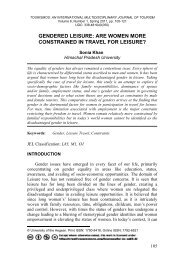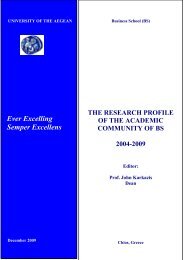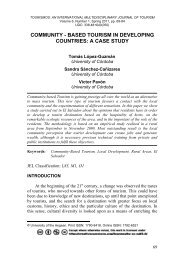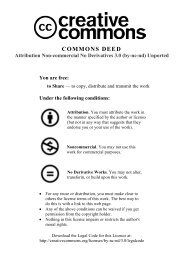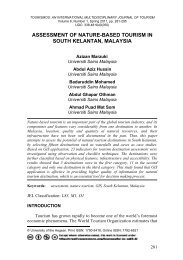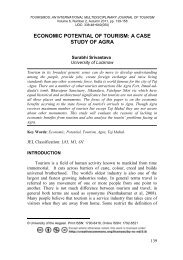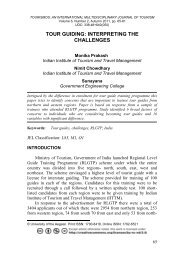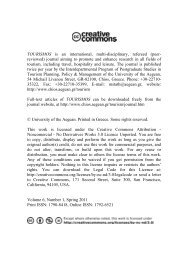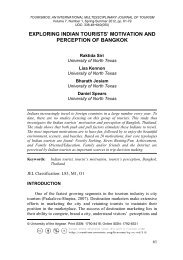EXPLORING TOURISTS' PERCEPTION: THE CASE OF ...
EXPLORING TOURISTS' PERCEPTION: THE CASE OF ...
EXPLORING TOURISTS' PERCEPTION: THE CASE OF ...
Create successful ePaper yourself
Turn your PDF publications into a flip-book with our unique Google optimized e-Paper software.
TOURISMOS: AN INTERNATIONAL MULTIDISCIPLINARY JOURNAL <strong>OF</strong> TOURISMVolume 7, Number 1, Spring-Summer 2012, pp. 81-98UDC: 338.48+640(050)private corporation into one organization for better coordination,promotion, development and marketing of tourism in Bangladesh(Hossain, 2006). Recently over 40 private tour operators have alreadybeen engaged in tourism marketing in Bangladesh. Some of them conductonly domestic (inbound) tours while others offer both domestic andoutbound tours (Bangladesh Monitor, 2007). Apart from that thirty twoprivate tour operators are members of an association named “ToursOperator Association of Bangladesh (TOAB)” to promote the country’stourism business to attract inbound and outbound tourists (Siddiqi, 2006).In 2005 Bangladesh recorded 207.662 inbound tourists. In terms ofregion the majority of the Bangladeshi tourists originated from SouthAsia (99.459), followed by Europe (48.961), East Asia and Pacific(35.976), US (18.673), Middle East (2.861) and Africa (1.730) (SourceBPC). In terms of existing tourist products, both inbound and homemarket, Rajshahi, Sylhet, Chittagong and Khulna Division are the maintourist divisions (Primary source Lonely Planet, 2004; Banglapedia, 2006;Encyclopedia of the Nations ,2007; UNESCO 2008a-c). However, inrecent times researchers reported that in country like Bangladesh tourist’ssafety and security issues are significant for the travellers (Embassy Webpagesof America, Norway and Denmark has been consulted in February2006).LITERATURE REVIEWChheang (2011) examines tourist perceptions and experiences andargues that tourist perception is positive and their experiences are beyondexpectations based on cultural enrichment and local people friendlinessplus local hospitality facilities. Holt (i.e., 2002: 80-82) referred thattourism being influenced by a “counter culture that opposes corporatismof all stripes”. According to Bowen (1998) consumers embrace tourism asan activity through which personal identity can be constructedautonomously and authentically. He also mentioned that travel andtourism industry has entered a postmodernist era. Because of thatEzeuduji1and Rid (2011) discover that to gain leadership in thetourism market few things need to be look after like value position,operational excellence and strong customer relations . On the other handHenderson (2011) in his research on Philippine highlighted that improperarrangement of infrastructure of a country seems to perceive negativelyby the international visitors to choose a destination. He also highlightedabout other factors that almost influence on inbound and outbound touristto travel like political instability, security and safety. Interestingly83
Muhammad Sabbir RahmanHigginbotham (2011) employ basic social psychological concepts in theinterrelated fields of recreation, leisure, and tourism. The result of hisstudy reveals that although possessing an intrinsic motivation and anelement of perceived freedom, travel for assisted-suicide is detached fromthe rewarding outcomes one normally receives from recreation, leisure,and tourism.Destination Brand ImageA brand image is a mental representation that always evokes in theconsumers mind. So brand image can be defined as “a unique set ofassociations within the minds of target customers which represent whatthe brand currently stands for and implies the current promise tocustomers” (All About Brands Index, 2005). Simeon (2006: 464) defines“a brand is a consistent group of characters, images, or emotions thatconsumers recall or experience when they think of a specific symbol,product, service, organization or location”. Branding must “attract andkeep customers by promoting value, image, prestige, or lifestyle” (i.e.,Rooney, 1995: 48). Brand must communicate information, minimize riskor increase trust, help to identify or recall, differentiate from competitionand facilitate recommendations (Palumbo & Herbig, 2000; Knox, 2004).Hsieh and Kai Li (2008) argued that consumer’s perception of anorganization’s brand is an antecedent of loyalty. In tourism brand imagesassociated with unique history, heritage and culture of a particulardestination (Hankinson, 2004).Travel and tourism is the highly competitive industry, there is apaucity of academic research on destination branding (Balakrishnan,2009). Foxall and Goldsmith (1994) indicate that branding and brandperceptions affect the consumer’s perceptions. Brand-managementstrategy as part of marketing strategy for a tourism industry (Pike, 2005).Because of that country like Britain also give importance to uplift itsbrand by launching a branding strategy (VisitBritain, 2006; Jowell, 2008).Since destination branding is complex and most of the literature is largelylimited to the image and logo design (Blain et al., 2005). Researchers alsobelieved that destination brands are similar to corporate brands, as theyact as umbrella brands for a portfolio of leisure, investment and businesstourism, and stakeholder and citizen welfare products (Trueman et al.,2004). A destination’s product and service portfolio must be integratedwith existing assets (Hankinson, 2004). For example it require strategiclocation (Siddiqi, 1999); infrastructure (airlines, ports, roads, technology);natural resources and other economic policies (tax free, economic free84
TOURISMOS: AN INTERNATIONAL MULTIDISCIPLINARY JOURNAL <strong>OF</strong> TOURISMVolume 7, Number 1, Spring-Summer 2012, pp. 81-98UDC: 338.48+640(050)zones and credit facilities) (Balakrishnan, 2008). Destinations thatdiversify their portfolio can able to reduce their risk; increase theirnumber of visitors and enhance loyalty (Rangan et al., 2006). Sometimesdestinations are looking at combinations of business based or vacationbased portfolios (Hankinson, 2005, 2004).Internet AdoptionNowadays internet is becoming a distribution channel for most ofservice oriented company that helps to accomplish the tasks of traditionalintermediaries for the travel agents and tour operators. In fact thesetourism organizations are being given new roles in the distributionchannel and will remain secure if their offering capability could bestrengthened by the presence of the internet, rather than if they functionedaccording to the more negative image of being simply a “bookingagency” (Law et al., 2004; Nysveen & Lexhagen, 2001; Law et al., 2004;Ozturan & Roney, 2004). During the last few years there has been anincreased use of the internet by tourists, travel agencies all over the world.Moreover, travel agents in a country like Bangladesh must have positiveattitudes towards internet applications and should believe that they cantake advantage of the internet technology to retain and attracting currentand future tourists (Maselli, 2002).Moreover tourist’s visit an agency’ssite is for the information or content. The term “content” refers to theinformation features or services that are offered in the web site (Huizingh,2000).Service QualityAccording to Leisen and Vance (2001) service quality helped tocreate the necessary competitive advantage by being an effectivedifferentiating factor. Service quality is essential and important for aservice provider company to ensure the quality service for establishingand maintaining loyal and profitable customer (Leisen & Vance, 2001).Johnson and Sirikit (2002) stated service delivery systems have the abilityto allow managers of a company to identify the real customer’s feedbackand satisfaction on their service. According to Wang and Lo (2002)marketing and economics quality often depended on the level of serviceattributes. Wal et al., (2002) argued that service quality reflects the extentto which a product or service meets or exceeds consumer’s expectations.By the way consumers prefer service quality when the price and othercost elements are held constant (Boyer & Hult, 2005). Customer85
Muhammad Sabbir Rahmanperceptions of the quality of a service are traditionally measuredimmediately after the person has consumed the service (Plamer & O’Neill2003). Crosby et al., (2003) found that perceptions of quality are createdand maintained in the minds of consumers.Customers SatisfactionAccording Yi (1990) the satisfaction measurement focuses primarilyon the disconfirmation model of expectations. He also claimed that thedesires of the consumer, as the key determinants of satisfaction. This viewwas supported by Spreng et al., (1996) who believed that the extent towhich a product or service fulfils a person’s desires are significant inshaping the individual’s feelings of satisfaction. Baker and Crompton(2000) also supported this view by indicating that factors such as desires,needs and disposition can influence the measurement of satisfaction.However “Attribute satisfaction” is the individual assessment of thedegree to which a product’s performance is perceived to have met orexceeded desires and expectations (Spreng et al., 1996). Bramwell (1998)suggested that the products of a destination should be designed to meetthe demand of the targeted customers.“Tourism satisfaction” refers to the emotional state of tourists afterexposure to the opportunity or experience (Baker & Crompton, 2000).Jayawardena (2002) points out that the future of tourism markets isdependent on the ability of tourism countries to deliver “a high qualityproduct that corresponds to the changing tastes, needs, wants anddemands of the international traveler”. The development of suchmarketing strategies requires tourism officials to measure the imagecustomers have of the destination’s tourism products and identify howsatisfied they are with the delivery of these products (Jayawardena, 2002).Tribe and Snaith (1998) also measured tourists’ satisfaction with theirholiday experience and pointed out that the measurement of satisfactionprovides some indication of the degree of customer loyalty. Kozak (2001)Gyte and Phelps (1989) found a relationship between overall satisfactionand intention to make a repeat visit.<strong>THE</strong>ORETICAL FRAMEWORKAbove all researchers in this research found that there is very limitedliterature focusing on tourist’s perception in selection of destination.Based on the literature review; this study proposes a conceptualframework of studying dynamics of tourists perception towards selection86
TOURISMOS: AN INTERNATIONAL MULTIDISCIPLINARY JOURNAL <strong>OF</strong> TOURISMVolume 7, Number 1, Spring-Summer 2012, pp. 81-98UDC: 338.48+640(050)of a destination. This framework emphasizes on the followingindependent and mediating variables: destination brand image, internetadoption, satisfaction, service quality. The independent variables of thisresearch are destination brand image and internet adoption which isrelated to the tourist’s perception in selecting a destination where theserelationships among them are mediated by service quality. On the otherhand this research also proposes that there is direct link betweensatisfactions of the tourists towards their perception of selecting adestination. The schematic diagram is presented below:Destination BrandInternet adoptionSatisfactionH1H2Service Qualityof a destinationH3H4Tourists’ Perceptionin Selection ofDestinationFigure 1 Theoretical framework of this studyTo test our variables we construct the following hypothesis:H1: Destination brand image plays a significant role on service quality ofa destination.H2: Internet adoption plays a significant role on service quality of adestination.H3: Customers satisfaction and tourist’s perception in selection ofdestination have significant relationship.H4: Destination brand image and internet adoption plays a significant roleon tourist’s perception in selection of destination, when service qualityplays a mediating role.METHODOLOGY <strong>OF</strong> THIS RESEARCHSince the major purpose of the study is to learn the tourist’sperception in the choice of a destination. In order to guarantee therepresentativeness of the population, convenient sampling method wereemployed, according to the criteria of significant location in Bangladesh(like Dhaka, Rajshahai, Khulna and Chitagong). Place of survey wereselected on the basis of some variables like (popularity, frequency ofvisiting by the tourists). The survey questionnaire consisted with five87
TOURISMOS: AN INTERNATIONAL MULTIDISCIPLINARY JOURNAL <strong>OF</strong> TOURISMVolume 7, Number 1, Spring-Summer 2012, pp. 81-98UDC: 338.48+640(050)higher values indicating higher reliability among the indicators (Hair etal., 1992). In accordance with the Cronbach alpha test, the total scale ofreliability for this study varies from .783, indicating an overall higherreliability factors. From table 1 it is showed that the reliability of thisstudy is substantial in every perspective.Table 1 Reliability Analysis for all VariablesCronbach's Alpha Based onCronbach's Alpha Standardized ItemsNo of Items.792 .783 25Factor analysisThe survey results obtained from 250 respondents have beenexplained in this section through the principal component analysis (PCA).It was carried out to explore the underlying factors associated with 20items. The constructs validity was tested through Bartlett’s Test ofSphericity and The Kaiser–Mayer–Olkin Measure of sampling adequacy.Result for the Bartlett’s Test of Sphericity and the KMO revealed fromthis study that both were highly significant. So this research concludedthat this variable was suitable for the factor analysis (Table 2).Table 2 KMO and Bartlett's TestKaiser-Meyer-Olkin Measure of Sampling Adequacy. .793Bartlett's Test of Sphericity Approx. Chi-Square 1465.826Df 168Sig. .000For this study, the general criteria were accepted items with loadingof 0.60 or greater. The result showed in explained total variance explainedby the two factors was 57.080%. The values of the following Table 3indicated the affiliation of the items to a factor. The higher loading(factor) indicates the stronger affiliation of an item to a specific factor.The findings of this study indicate that each of the four dimensions(destination brand image, customer’s satisfaction, internet adoption, andservice quality) was homogeneously loaded to the different factors. On89
Muhammad Sabbir Rahmanthe other hand the reliability coefficients for the four factors: destinationbrand image, customer’s satisfaction, internet adoption, and servicequality were 0.79, 0.78, 0.83 and 0.86 respectively. As Table shows, allalpha coefficients for the data exceed the minimum standard for reliabilityof 0.70 recommended by Nunnally (1978). Thus, the results indicate thatthese multiple measures are highly reliable for measuring each construct.Table 3 Reliability Analysis and Factor LoadingMean Std. Deviation FactorLoadingDestination Brand Name (Alpha = .79)(di) High degree history and heritage 4.65 1.369 .682(di2) Feeling of ambience and experience 5.79 1.525 .713(di3) International reputation 4.69 1.552 .651(di4) Degree experience of exploration and naturalwonders4.58 1.669 .663Internet adoption (Alpha = .78)(ia1) Standardize the sale processes and service 4.86 1.291 .641delivery through internet(ia2) Standardize the travel products or services 3.65 1.385 .882(ia3) Well established on line transaction 5.79 1.425 .763(ia4) Offering multiple choices in travel services 5.58 1.456 .694Customers Satisfaction ( Alpha = .83)(cs1) Quality hotels and restaurants 4.58 1.636 .591(cs2) Vacation met all expectations 6.54 1.587 .685(cs3) Superior value for money 4.68 1.624 .769(cs4) Fine local transportation system 4.75 1.268 .743Service Quality (Alpha = .86)(Sq1)Provide services as it promise 4.38 1.536 .685(Sq2) Perform services right at the first time 5.54 1.487 .621(Sq3)Performance of stable service 4.28 1.324 .712(Sq4)Service variety are very attractive 5.75 1.368 .628Confirmatory Factor AnalysisThe second phase of data analysis consisted with confirmatory factoranalysis. To this end the structural equation method (SEM) was applied,using maximum likelihood estimation method to test the hypothesis of thestudy (Bentler, 1995). Although this research has already employed EFA90
TOURISMOS: AN INTERNATIONAL MULTIDISCIPLINARY JOURNAL <strong>OF</strong> TOURISMVolume 7, Number 1, Spring-Summer 2012, pp. 81-98UDC: 338.48+640(050)for verifying grouping and loading pattern of measuring scale items, it hasfurther attempted to screen EFA examination by conducting CFA amongall the exogenous variables (destination brand image, internet adoption,and service quality and customers satisfaction) with measuring itemsretained by EFA.Destination Brand ImageFor destination brand, the modification indices for the covariance ofmeasurement errors were: 11.844 between di2 (“Feeling of ambience andexperience”) and di1 (“High degree history and heritage”) and 15.799between di3 and di4 (“International reputation” and “Degree experienceof exploration and natural wonders”). These two sets of measurementerror are logically conceivable to be correlated (Figure2). Therefore thesecorrelated relations were allowed in the model. Each pair was added tothe measurement model one at a time. After adding these threeparameters, testing of the revised measurement model showed: χ²/d.f. =1.366 (χ²=17.768, d.f=13); GFI= .982, AGFI=.972, CFI=.971, NFI=.962and RMSEA= .040.Internet AdoptionFrom our EFA (exploratory Factor Analysis) as shown in table 2, wehave retained 4 measuring items for internet adoption. The default modelfit indices of internet adoption were adequate. The measurement model fitindices of internet adoption showed an adequate fit: χ²/d.f. = .079(χ²=12.769, d.f=9); GFI= .972, AGFI=.947, CFI=.975, NFI= .953 andRMSEA= .047.Customer’s Satisfaction and Service QualityFrom EFA as shown in table 3, have retained 4 measuring items forcustomer’s satisfaction and service quality variable. This study haveretained all these items after conducting CFA, as all those indicators wereloaded with loading factor more than 0.70. The measurement model fitindices of customer’s satisfaction and service quality showed an adequatefit: χ²/d.f. = 1.32 (χ²=15.852, d.f=12); GFI= .963, AGFI= .953, CFI= .969,NFI= .957, RMSEA= .050; χ²/d.f. = 1.222 (χ²=13.452, d.f=11); GFI=.973, AGFI= .963, CFI= .969, NFI= .957 and RMSEA= .040.91
Muhammad Sabbir Rahman.31.19 -.32.96 .75 .37 .36 .57 .96 .54 .67e11e21e31e41e131e141e151e161db1 db2 db3 db4 sq1 sq2 sq3 sq42.03 3.071.031.00 DB 3.23 1.001.11 .91SQ11.40 .07e211.30 .2611.57e8 1 ia1.38.12.59.46 e7 1 ia2 1.06 1.491.00 1.81 e6 1 ia3 IA1.05 tp1 1 e17.83 e5 ia4 1.00TP tp2 1 e18 .56.721 tp3 1 e19.31.94 tp4 e20 .70e22 .80.721.471.33 CS 1.221.00.43cs11cs21cs3 1 1cs4e12 e11 e10 e9.67 .57 .60 .99Figure 2: Factors Influencing Tourist’s Perception in Selection ofDestination Model (For Total Sample): Default Model. (DestinationBrand =DB, Internet Adoption=IA, Customer Satisfaction= CS;Service Quality = SQ, Tourist perception= TP)Statistical Significance Of Parameter EstimatesIn this stage data analysis this research utilized critical ratio (C.R)value, which represents the parameter of an estimate divided by itsstandard error. Based on a probability level 0.05 the test statistic needs tobe >±1.96 before the hypothesis (that estimates equals 0.0) can berejected. On the other hand, it is also important to note that nonsignificantparameters can be indicative of a sample size that is too small (Byrne,2001).Table 3 Standard Estimation of the Main ModelStandardized regression weight Estimate S.E. C.R. PH1H2H4H3ServiceQuality (SQ)ServiceQuality (SQ)Tourist’sPerception(TP)Tourist’sPerception(TP)DestinationBrand Image(DB)InternetAdoption(IA)ServiceQuality(SQ)CustomersSatisfaction(CS)value1.403 .311 4.519 ***.306 .068 4.475 ***.115 .070 1.643 .100.719 .117 6.155 ***92
TOURISMOS: AN INTERNATIONAL MULTIDISCIPLINARY JOURNAL <strong>OF</strong> TOURISMVolume 7, Number 1, Spring-Summer 2012, pp. 81-98UDC: 338.48+640(050)Hypotheses TestingThe structural equation model was examined to test the relationshipamong the constructs. After adjustment of the model by observing themodification indices value goodness-of-fit indicates for this model werechi-square/df = (623.383 /164) =3.8o11, GFI = 0.92, AGFI = 0.91, CFI =0.89, NFI = 0.85, RMSEA= 0.006. Figure 2 depicts the full model. Afterobserving the statistical test it is been clear that all the paths are notsignificant at p < 0.05. (H1) Destination brand image plays a significantrole on service quality of a destination. Therefore null hypotheses H1 isaccepted at 0.5 level of significance p > 0.000. Regarding the H2: Internetadoption plays a significant role on service quality of a destination.Therefore, this null hypothesis is accepted at p < 0.000. H3: Customerssatisfaction and tourist’s perception in selection of destination havesignificant relationship. This null hypothesis is also accepted at p < 0.000.But H4: Destination brand image and internet adoption plays a significantrole on tourist’s perception in selection of destination, when servicequality plays a mediating role. This null hypothesis is rejected at 0.5 levelof significance p > 0.000. Among all the significant variables, destinationbrand image has the highest estimate (1.403) followed by customer’ssatisfaction (.719); internet adoption (.306). Overall destination brandimage and internet adoption plays the most significant role on tourist’sperception in selection of destination in Bnagladesh.CONCLUSIONThe objective of the research is to figure out factors influencingtourist’s perception in selection of destination Bangladesh as a touristdestination. This research also tries to identify the most significantattributes that satisfy tourist’s needs in order to attract new visitors. Theresults of the structural equation modeling reflected that destinationbrand image, internet adoption and customers satisfaction played asignificant role that are influencing tourist’s perception in selection of adestination for travelling in Bangladesh. In response to the researchobjective relating to the tourists’ needs and satisfaction, the findingsshowed that “Feeling of ambience and experience”, “Internationalreputation of the visiting place” “Standardize online services salesprocesses and service delivery through internet” “Well established on linetransaction” and “Superior value for money” “Fine local transportationsystem” are the significant items influencing tourists’ perception inselection of destination for travelling in Bangladesh.93
Muhammad Sabbir RahmanMANAGERIAL IMPLICATIONS AND RECOMMENDATIONSThe results of this study can provide marketing researchers andplanners with some valuable view into the choice of appropriate marketsbased on the unique attributes of the destination, which can differentiate itin the tourists’ minds and also meet the tourist’s demand. It isrecommended that managers of tourism business especially hotel andresort should ensure the provision of top quality service, restaurants withhigh standard security. Promotional activities through the internet andother electronic media including TV can be utilized to attract the new andexisting tourists.Bangladesh Government should be taken necessary measures toencourage the private sector to play positive role in the development anddiversification of tourist facilities to promote domestic and internationaltourism in the country. From a managerial perspective, this researchindicates the necessity for mangers to understand what motivates touriststo visit Bangladesh. The research also highlighted the perception oftourists which can drive a manager to understand their behaviour.LIMITATIONS AND FUR<strong>THE</strong>R STUDIESA number of limitations should be acknowledged here to informfuture research. The survey was conducted only for two months, whichpermitted only winter tourists to be surveyed. Thus, most of therespondents were winter tourists not representative of year round tourism.Only few dimensions were analyzed in this study, so further research canbe done by using factors such as socio cultural, outdoor activities,Income, cultural distance with larger sample size.REFERENCESAll about Brands Index. Http://www.allaboutbranding.com/index.lasso. Accessedthe 15 th of September 2005, at 12:35.American Embassy. Http://www.infozee.com/usa/embassies/bangladesh.htm –Dhaka, Bangladesh. Accessed the 30 th of December 2010, at 2:35.Anderson, J.C. & Gerbing, D.W. (1988). Structural equation modeling in practice:A review and recommended two-step approach. Psychological Bulletin,Vol. 103, pp.411-423.Baker, D. & Crompton, J. (2000). Quality, satisfaction and behavioral intentions.Annals of Tourism Research, Vol. 27, No.3, pp.785-804.94
TOURISMOS: AN INTERNATIONAL MULTIDISCIPLINARY JOURNAL <strong>OF</strong> TOURISMVolume 7, Number 1, Spring-Summer 2012, pp. 81-98UDC: 338.48+640(050)Balakrishnan, M.S. (2009). Commentary strategic branding of destinations: aframework. European Journal of Marketing, Vol. 43, No.5/6, pp.611-629.Banglapedia. (2006). National Encyclopedia of Bangladesh’ CD edition. Asiaticsociety of Bangladesh.Bentler, P.M. & Bonett, D.G. (1980). Significance tests and goodness-of–fit in theanalysis of covariance structures. Psychological Bulletin, Vol. 88, pp.588-606.Blain, C., Levy, S.E. & Ritchie, J.R.B. (2005). Destination branding: insights andpractices from destination management organizations. Journal of TravelResearch, Vol. 43, No.4, pp.328-338.Bowen, J.T. (1998). Market segmentation in hospitality research: no longer asequential process. International Journal of Contemporary HospitalityManagement, Vol. 10, No.7, pp.289-96.Boyer, K.K. & Hult, G.T. (2005). Customer Behaviour in an Online OrderingApplication: A Decision Scoring Model. Decision Sciences, Vol. 36, No.4,pp.569-598.Bramwell, B. (1998). User satisfaction and product development in urban tourism.Tourism Management, Vol. 19, No.1, pp.35-47.Chheang. V. (2011). Angkor Heritage Tourism And Tourist Perceptions.Tourismos: An International Multidisciplinary Journal of Tourism, Vol. 6,No.2, pp.213-240.Crosby, L.B., DeVito, R. & Pearson, J.M. (2003). Manage Your Customers’Perception of Quality. Review of Business, Vol. 24, pp.18-38.DCMS (2006). A Stronger Voice for British Tourism, A New Marketing Force forEngland. Http://www.culture.gov.uk/tourism/ Accessed the 22 nd of May2007.Embassy of Denmark, Dhaka Bangladesh Http://www.ambdhaka.um.dk/enEmbassy of Norway in Bangladesh Http://www.norway.org.bd/info/embassy.htmEncyclopedia of the Nations (2007) ‘Bangladesh – Overview of economy’Fish, A.J. (2005). Assisting cross-border manager adjustment: psycho-cultural andsocio-cultural interventions. Personnel Review, Vol. 34, No.2, pp.225-245.Fornell, C. & Larcker, D.F. (1981). Evaluating structural equation models withunobservable variables and measurement error. Journal of MarketingResearch, Vol. 18, pp.39-50.Foxall, G.R. & Goldsmith, R.E. (1994). Consumer psychology for marketing:Perceptual process, pp.49.Gyte, D. & Phelps, A. (1989). Patterns of destination repeat business: Britishtourists in Mallorca, Spain. Journal of Travel Research, Vol. 28, No.1,pp.24-8.Henderson, J.C. (2011). 1 Tourism Development And Politics In The Philippines.Tourismos: An International Multidisciplinary Journal Of Tourism, Vol.6, No.2, pp.159-173Higginbotham, G. (2011). Assisted-Suicide Tourism: Is It Tourism? Tourismos:An International Multidisciplinary Journal Of Tourism, Vol. 6, No.2, pp.177-185.95
Muhammad Sabbir RahmanHankinson, G. (2004). The brand images of a tourism destination: a study of thesaliency of organic images. Journal of Product & Brand Management,Vol. 13, No.1, pp.6-14.Hankinson, G. (2005). Destination brand image: a business tourism perspective.Journal of Services Marketing, Vol. 19, No.1, pp.24-33.Holt, D.B. (2002). Why do brands cause trouble? A dialectical theory of consumerculture & branding. Journal of Consumer Research, Vol. 29, No.1, pp.70-90.Hossain, M.A. & Nazmin, S., (2006). Development of Tourism Industry inBangladesh- an empirical study on its problems and prospects. Centre forTourism and Hotel management Research, Ga-1, Rashedul Hasan Bhaban,University of Dhaka, and DhakaHsieh, A.D. & Tung, C.L.L. (2008). The moderating effect of brand image onpublic relations perception and customer loyalty. Marketing Intelligence &Planning, Vol. 26, No.1, pp.26-42.Huizingh, E. (2000). The content and design of web sites: an empirical study.Information and Management, Vol. 37, No.3, pp.123-34.Ikechukwu O., Ezeuduji, I.O. & Rid, W. (2011). Rural Tourism Offer And LocalCommunity Participation In The Gambia. Tourismos: An InternationalMultidisciplinary Journal Of Tourism, Vol. 6, No.2, pp.187-211.Jayawardena, C. (2002). Mastering Caribbean tourism. International Journal ofContemporary Hospitality Management, Vol. 14, No.2, pp.88-93.Johnson, W.C. & Sirikit, A. (2002). Service Quality in the ThaiTelecommunication Industry: A Tool for Achieving a SustainableCompetitive Advantage. Management Decision, Vol. 40, No.7, pp.693-701.Joreskog, K.G. & Sorbom, D. (1996). LISREL 8: Users’ Reference Guide,Scientific Software International, Chicago, IL.Jowell, T. (2008). Tomorrow’s Tourism Today; Marketing Strategy, Secretary ofState for Culture, Media and Sport. 08, London.Kandampully, J. (2000). The impact of demand fluctuation on the quality ofservice: a tourism industry example. Managing Service Quality, Vol. 10,No.1, pp.10-18.Kelloway, E.K. (1998). Using LISREL for Structural Equation Modeling. AResearcher’s Guide. London, Sage.Knox, S. (2004). Positioning and branding your organization. Journal of Product& Brand Management, Vol. 13, No.2, pp.105-15.Kozak, M. (2001). Repeaters’ behavior at two distinct destinations. Annals ofTourism Research, Vol. 28, No.3, pp.784-807.Law, R., Leung, K.A. & Wong, J. (2004). The impact of the internet on travelagencies. International Journal of Contemporary HospitalityManagement, Vol. 16, No.2, pp.100-7.Leisen, B. & Vance. C. (2001). Cross-national Assessment of Service Quality inthe Telecommunication Industry: Evidence from the USA and Germany.Managing Service Quality, Vol. 11, No.5, pp.307-317.Lonely Planet (2004). ‘Bangladesh’ McAdam. M. Lonely Planet96
TOURISMOS: AN INTERNATIONAL MULTIDISCIPLINARY JOURNAL <strong>OF</strong> TOURISMVolume 7, Number 1, Spring-Summer 2012, pp. 81-98UDC: 338.48+640(050)Maselli, J. (2002). E-ticketing threatens travel agents. Information Week, No.881,pp. 28-9.Ministry of Civil Aviation and Tourism. (2004). Travel and Tourism YearlyReport. Published by the Ministry of Civil Aviation and Tourism,Bangladesh.Mowlana, H. & Smith, G. (1993). Tourism in a global context: the case offrequent traveller programs. Journal of Travel Research, Vol. 33, No.3,pp.20-27.Nysveen, H. & Lexhagen, M. (2001). Swedish and Norwegian tourism websites:the importance of reservation services and value-added services.Scandinavian Journal of Hospitality and Tourism, Vol. 1, No.1, pp.38-44.Ozturan, M. & Roney, S. (2004). Internet use among travel agencies in Turkey:an exploratory study. Tourism Management, Vol. 25, No.2, pp.259-66.Palumbo, F. & Herbig, P. (2000). The multicultural context of brand loyalty.European Journal of Marketing, Vol. 3, No.3, pp.116-24.Parjatan (The Bangladesh Parjatan Corporation) www.bangladeshtourism.gov.bd/Pike, S. (2005). Tourism destination branding complexity. Journal of Product &Brand Management, Vol. 14, No.4, pp.258-9.Plamer, A. & O’Neill, M. (2003). The effects of perceptual processes on themeasurement of service quality. Journal of Services Marketing, Vol. 17,No.3, pp.254-274.Poon, W. & Low, K. (2005). Are travellers satisfied with Malaysian hotels?International Journal of Contemporary Hospitality Management, Vol. 17,No.3, pp. 217-227.Rangan, V.K., Elberse, A. & Bell, M. (2006). Marketing New York City. HarvardBusiness Case Studies, April 27, Harvard Business School of Publishing,Boston, MA.Rooney, J.A. (1995). Branding: a trend for today and tomorrow. Journal ofProduct & Brand Management, Vol. 4, No.4, pp.48-55.Siddiqi, R. (2006). Tourism in Bangladesh suffers: Policy makers lackunderstanding, government lacks strong intention. The Independent March16th, Dhaka, Bangladesh.Siddiqi, S. (1999). Strategic geography and strategic corporate challenges: aregiocentric perspective to the Middle East. Managerial Finance, Vol. 25,No.2, pp.45-62.Simeon, R. (2006). A conceptual model linking brand building strategies andJapanese popular Culture. Marketing Intelligence & Planning, Vol. 24,No.5, pp.463-476.Spreng, R., MacKenzie, S. & Olshavsky, R. (1996). Re-examination of thedeterminants of consumer satisfaction. Journal of Marketing, Vol. 60,No.3, pp.15-35.Tabibi, M. & Rohani, A (2011). Jet Ski Development Strategies: The Case ofCaspian Sea`S South-West Beach. Tourismos: An InternationalMultidisciplinary Journal of Tourism, Vol. 6, No.2, pp.175-192.97
Muhammad Sabbir RahmanTribe, J. & Snaith, T. (1998). From SERVQUAL to HOLSAT: holidaysatisfaction in Varadero, Cuba. Tourism Management, Vol. 19, No.1,pp.25-34.Trueman, M., Klemm, M. & Giroud, A. (2004). Can a city communicate?Bradford as a corporate brand. Corporate Communications: AnInternational Journal, Vol. 9, No.4, pp.317-30.Tucker, L.R. & Lewis, C. (1973). The reliability coefficient for maximumlikelihood factor analysis. Psychometrika, Vol. 38, pp.1-10.UNESCO Seal of Excellence (SEAL) programmeHttp://www.unescobkk.org/index.php?id=483 Accessed the 25 th ofFebruary 2008, at 11:35.Uzama, A. (2008). Marketing Japan’s tourism to the world. Paper presented at theAnnual Conference of British Association of Japanese studies inUniversity of Manchester, Manchester 11-12 April.VisitBritain. (2006). Key Tourism Facts, www.visitbritain.com/corporate/ factsfigures/index.aspx Accessed the 23 rd of May 2007, at 14:55.Wal, R.W.E., Van der Pampallis, A. & Bond, C. (2002). Service Quality in aCellular Telecommunications Company: A South African Experience.Managing Service Quality, Vol. 12, No.5, pp.323-335.World Tourism Organization. (2008). UNWTO World Tourism Barometer,UNWTO, Madrid, Vol. 6, No.1, pp.1-5.World Travel and Tourism Council. (1995). Travel and Tourism: A NewEconomic Perspective, Elsevier Science, and Oxford.Yi, Y. (1990). A critical review of consumer satisfaction. In V.A. Zeithaml (Eds.)Review of Marketing (pp.68-123), Chicago, IL: American MarketingAssociation.SUBMITTED: MAR 2011REVISION SUBMITTED: OCT 2011ACCEPTED: DEC 2011REFEREED ANONYMOUSLYMuhammad Sabbir Rahman (sabbiriiu@gmail.com) is a lecturer at theMultimedia University, Cyberjaya Campus (Malaysia), Jalan Multimedia,63100 Cyberjaya, Selangor, Malaysia under Faculty of Management.98



